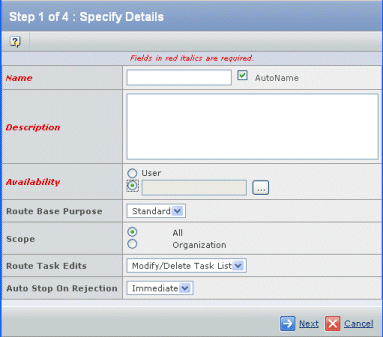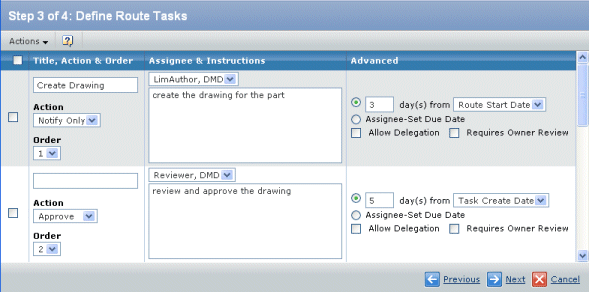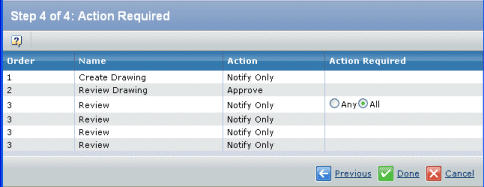Creating a Route Template | |||
| |||
Enter Basic Information for the Route Template
Select Create New from the page Actions menu or toolbar.
The first page of the wizard opens, the Specify Details page.

Enter these details:
Field Name Description Name The name you want to use for the new route template, or check Autoname to have the system assign a name. When a route template is autonamed, the system assigns a prefix and a sequential number for the name, such as R-000305. Description Indicates the route's purpose. Availability Defines who can use the template to create a route: - User. The template will be available only to you.
- Enterprise. The template will be available to everyone. Only Company Representatives can create Enterprise-level route templates. You can click
 to specify an Owning Organization responsible for the template. You can select a plant to define access for manufacturing resposibility for approval and distribution lists.
to specify an Owning Organization responsible for the template. You can select a plant to define access for manufacturing resposibility for approval and distribution lists. - Workspace or project space (option not labeled). You can also click
 to select a workspace or project space to limit the template use. The template will be available to any member of the selected workspace. This option does not restrict the route template to the selected workspace.
to select a workspace or project space to limit the template use. The template will be available to any member of the selected workspace. This option does not restrict the route template to the selected workspace.Note: If a user has access to a route template based on workspace membership, that user can create a route based on that template from any page within the ENOVIA system. If the user creates a route from the Routes category for a Workspace, the user can access any route template they have access too, not only the route templates that have that workspace defined for availability.
Route Base Purpose Determines the kind of tasks included in the route. - Standard. The route can include tasks that require the assignee's approval or comment or tasks intended only for notification or information.
- Approval. The route includes only tasks that require the assignee's approval.
- Review. The route includes only tasks that require the assignee's comment.
Scope All or Organization. You can click  to choose a specific workspace or folder. For details, see The Scope of a Route.
to choose a specific workspace or folder. For details, see The Scope of a Route.
Route Task Edits Choose an option from the list to choose how people who create routes based on the template can edit the task list. The editing restrictions apply to adding and removing tasks, changing the task order, and changing the task name only. The route owner can edit all other fields, such as task assignee, instructions, and due dates, no matter what the Route Edit Task option is. - Maintain Exact Task List. People who create a route from this template must use the exact task list, with no tasks added or removed. The route creator cannot make any changes to the task order or names, but all other fields can be changed.
- Extend Task List. People who create a route from this template must use the exact task list, but more tasks can be added to an existing route task order number or a new order. The route creator cannot make any changes to the order or names of tasks from the route template, but can change all other fields. The route owner can make any changes to tasks the owner adds to the route.
- Modify Task List. People who create a route from this template can change all information for template tasks except the task name. The route creator can add new tasks but cannot delete template tasks.
- Modify/Delete Task List. People who create a route from this template can change and delete any task and can add new tasks.
Auto Stop on Rejection Determines what happens when a task in the route is rejected: - Immediate. The route stops immediately.
- Deferred. The route stops after other tasks at the current level are completed or rejected.
Click Next.
![]()
Add Members and Define Access
Complete the steps above. The Select Route Members page of the wizard opens.
This page is identical to the Add Members and Define Access page for a route. See Add Members and Define Access for details.
Click Next.
![]()
Define Tasks for the Route Template
Complete the steps above. The Define Route Tasks page of the wizard opens.

One task is included for each member added in the previous page.
For each task, specify these details:
Field Name Description Name Enter a short name to let the assignee know what the task is about. Action What you want the task assignee to perform. The action does not affect the person's access to the route's content. - Approve
In addition to filling in the Comment box, the task recipient must choose an approval status: Approve, Reject, or Abstain. If the task assignee chooses Approve or Abstain and then completes the task, the route continues as usual. If the task assignee chooses Reject and then completes the task, the route is stopped and the route creator is notified. The system does not create the next task in the route until the route creator resumes the route. Whether the Comments field for the Approve action is displayed can be configured by your ENOVIA Administrator. For details, see "Route Properties" in the Business Process Services Administrator's Guide.
- Comment. The recipient must enter a comment before completing the task.
- Notify Only. If you choose this option, the task is automatically completed without the recipient taking any actions.
Order A number to define the order in which you want the tasks to be performed. If tasks can be performed concurrently (do not depend on the completion of other tasks), choose the same order number for each task. For example, suppose you want one person to complete a task and then you want two people to work on a task simultaneously. You would choose an order number of 1 for the first task. The other two tasks should have order number 2.
Assignee & Instructions Choose the person, group, or role who should receive the task from the drop-down list. You can leave the task unassigned until you are ready to start the route. If you assign a group or role to a task, the system notifies all people in the group or role when the task is created. The first person to accept the task is then assigned to the task and is the only person who can complete it.
Enter instructions for the task. Provide a detailed description of what the person should do to complete the task. For example, you may want to indicate which file or section they should review or comment on.Due Date & Time Specify the due date/time as the number of days following the route start date or task creation date (the date the previous task assignee completes his/her task). Click the second button under the Due Date & Time column. Enter the number of days from and select whether it should be calculated from the Route Start or Task Creation date. When calculating the due date, the system includes weekends and holidays so factor that into the number of days you enter. The maximum number of days is 365. For example, if you want to give the task assignee 10 working days to complete the task, you should enter 14 from the Task Create Date because it's likely there would be 4 weekend days within a 10-day working period. If you want the task to be complete 30 calendar days following the start of the route, you should enter 30 days from Route Start Date.
Assignee-Set Due Date Let the task assignee enter a due date by choosing . Click the third button under the Due Date & Time column. The task assignee can enter a due date, although the system does not require one. If no due date is entered, the system does not display a status for the task. If the assignee does not complete the task by the due date/time, the task is marked as late (red) and the route's status is changed from green to yellow. If late task notifications have been set up, the system sends out notifications to the appropriate people. For sub-routes, the system makes sure none of the task due dates are later than the parent task's due date. If they are, you must make the due dates earlier.
Allow Delegation If a task allows delegation, the assignee can delegate the task to another member to complete. See Reassigning (Delegating) a Task to Someone Else. The delegate will temporarily inherit all accesses that the assignee has for the route and its content. The system may also delegate the task automatically if the recipient receives the task during a defined absence period and the person has designated an Absence Delegate on the person profile. When the system automatically delegates a task, it also notifies the route owner.
The Tasks page will show a Delegate
 icon for the tasks.
icon for the tasks.Needs Owner Review Check if you want to review a task after the assignee completes it. After the assignee completes the task, the system notifies you. After reviewing the task, you must enter a review comment and then either promote the task to indicate approval or demote it to indicate rejection. The system does not create the next task in the route until you promote the task. Demoting the task changes its state back to Assigned and the assignee must recomplete the task based on your comments. When demoting the task, you can reassign it to someone else to work on.
The Tasks page will show a Requires Owner Review
 icon for the task.
icon for the task.- Approve
To assign multiple tasks to a single individual (or role or group):
- Check the needed tasks.
-
Select Assign Selected from the page Actions menu or toolbar.

- Select the person, role, or group.
- Click Done.
To assign one member to several tasks, check those tasks and click Assign Selected from the page Actions menu or toolbar. Then choose the member from the Assign Tasks page and click Done.
Use the page Actions menu or toolbar to work with tasks:
- Add Task. Define additional tasks. A new task row is added. Repeat steps 2 through 6 to define the task.
- Remove Selected. Remove a checked task.
- Sort Task List. Sort the list of tasks based on ascending order number and then by task name.
Click Next.
![]()
Set Action Required for the Route Template
Complete the steps above. The Action Required page of the wizard opens.

If there are no concurrent tasks in the route, the Action Required column is empty.
For each set of concurrent tasks, choose whether any or all must be completed before the next task(s) becomes pending.
- Any. When one person completes a task in the set of concurrent tasks, the task or tasks in the next order level become pending and the remaining incomplete tasks in the current order level are deleted. For example, if you assign three concurrent tasks to three people and ask that they approve a document in the route, but you only need approval from one of them so as soon as one of them completes the task, the other tasks can be deleted and the next task in the route can proceed.
- All. All tasks in the set of concurrent tasks must be complete before the next order level tasks become pending.
Click Done.